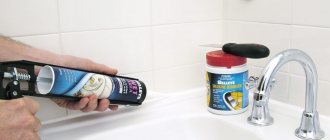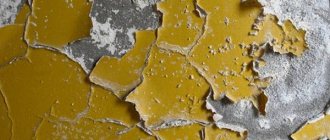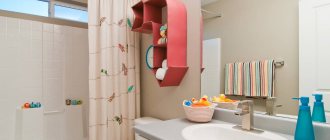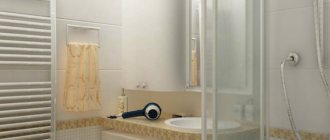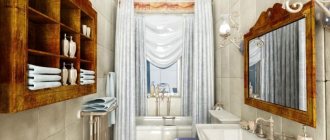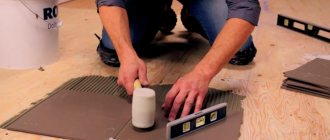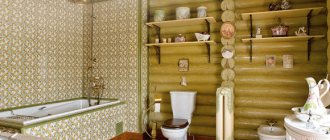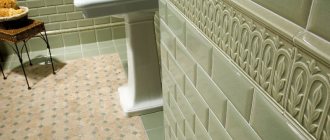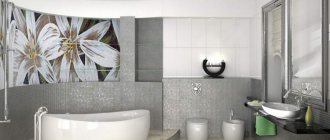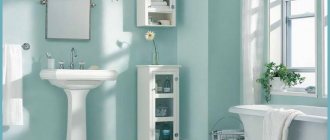Many people often underestimate such a phenomenon in the bathroom as fungus. Some people simply don’t pay attention to it, others occasionally clean the surfaces of these formations. In fact, fungus in the bathroom poses a much more serious threat than you might imagine. Therefore, the fight against it is an obligatory component of maintaining the premises. It negatively affects not only the room itself, making it unattractive. The main threat is the danger to humans, small children and even animals living in your home.
As numerous studies show, the spores formed by the fungus and which we inhale every day in our bathroom can lead to the following problems and diseases:
- Runny nose;
- Asthma;
- Allergic skin diseases;
- Severe headaches;
- Nausea;
- Persistent cough;
- Rheumatic pain, etc.
Do you want to experience this? Hardly. Therefore, if you find a fungus, immediately begin to fight it. There are many ways and techniques for this. The main thing is simply not to be lazy, but to identify the problem in a timely manner and get rid of it.
Causes of fungus
Of all the rooms, the bathroom is the most vulnerable. The climate that forms here provides favorable conditions for the development of the fungus. And if there are no characteristic dark spots in the new house or apartment, it’s just a matter of time. As soon as the humidity level rises and the functionality of the ventilation system deteriorates, the fungus will immediately make itself known. What is typical is that the type of surface does not matter - it can be either painted concrete or modern plastic.
Why does black mold appear?
The best place for mold spores to grow is the washing machine.
Mold in the washing machine
All its corners, inaccessible and damp, can be confidently called true breeding grounds for fungus. In principle, spores are constantly present in the home, but only bloom under favorable conditions.
Table. Why does fungus develop?
| Cause | Short description |
| High humidity (more than 90%) | If we talk specifically about the bathroom, there is no way to get rid of humidity unless you simply stop visiting this room. After each water procedure, condensation forms on the surfaces of the room (ceiling, walls, etc.), which contributes to the spread of fungus. |
| No antiseptic treatment | If, during finishing, you do not treat the room with special compounds in a timely manner (or do not treat it at all), then the mycelium will easily settle on the walls, in various kinds of joints (including between tiles) and other places. |
| Lack of natural light | Without windows in the bathroom, the lack of natural ultraviolet light can lead to the development of fungus. The fact is that UV rays have a detrimental effect on it. |
| Heat | If the temperature in this room exceeds +20°C, then the likelihood of fungus appearing increases significantly. |
| Poor/no ventilation | If the diameter of the ventilation opening is insufficient or the exhaust air ducts are clogged, air circulation will be disrupted. Humid air will remain in the room instead of leaving it. And this is also one of the provoking factors. |
When at least one of the listed conditions occurs, thin lines of mold mycelium appear on all wet surfaces and begin to multiply quite quickly. Almost everyone is probably familiar with the characteristic dark gray pattern, accompanied by a musty smell. If nothing is done in the early stages of fungus development, then over time the plaster, paint and other finishing layers will begin to peel off, and cracks will form on the concrete surface. After this, all consequences can be eliminated only through repairs.
Reasons for the invasion of uninvited “guests”
Before you learn how to remove fungus in the bathroom, you need to find the reasons that provoked its appearance. If they are not installed, then you can forget about the final victory over the enemy: the fungus will soon return to its “native land”.
Ideal conditions for its existence are high humidity (90% or higher) and warmth. The bathroom meets these requirements - a small, constantly “wet” room, which is also equipped with a heating system.
The owners themselves sometimes contribute to attracting fungus by simply forgetting to carry out the necessary antiseptic treatment of surfaces. There are other culprits:
- insufficient quality ventilation system, unable to remove warm, stagnant air;
- poorly equipped waterproofing of all surfaces of a wet room, because of which the coatings become damp and become the best home for fungal colonies;
- plastic windows that are not equipped with special supply ventilation valves;
- water (condensation) constantly accumulating on furniture, plumbing equipment or household appliances;
- the door to the bathroom, which is always (even after water procedures) kept tightly closed;
- small, hidden, leaks from pipes, they are almost invisible to the eye;
- insufficient lighting, lack of windows.
Not all conditions together mean the inevitable appearance of uninvited guests, since only a few “fungal favors” from this list are often enough for their unexpected visit.
Why is fungus in the bathroom dangerous?
The habitat of mold mycelium is very diverse. This can be not only brick or concrete, but also various paint and varnish coatings. Sometimes the fungus is difficult to notice at all, because it can even develop under the tiles.
Actively developing, he can:
- destroy building materials, which can lead to possible collapse of the structure;
- worsen the aesthetic properties of the finish;
- pose a danger to human health.
Regarding the last point, the spores enter the respiratory organs, which can lead to the development of:
- asthma;
- allergies;
- other serious diseases (including joint damage).
It is for this reason that at the first signs of fungal development it is necessary to take urgent measures.
Fungus in the bathroom: a dangerous neighborhood
Important points of the process
Let’s immediately make a reservation that you should get rid of not the visible signs of damage, but directly from the source of the problem. The visible part is dark spotting, and the focus is the mycelium (the latter is what needs to be removed). Look for the hearth not on the surface, because it is often hidden deeper, in a more humid and less lit place - in various voids, under the finishing material.
To remove a layer of mold mycelium, use a regular scraper - scrape off the affected areas with it.
Spatula-scraper
Also clean the seams between the tiles if they are damaged and remove all grout.
Removing grout from tile joints
If the tile is about to fall off, it means that a breeding ground is also hidden in it - remove it and treat the exposed surfaces.
How to remove tiles in the bathroom
All further actions must be carried out in a dry room. For this reason, arm yourself with a hair dryer (it’s convenient for heating cleaned areas) or, if you don’t have one, use a regular household heater.
General appearance of a construction hair dryer with its names of individual parts
After drying everything, start fighting the fungus using special means (more on them later). It is very important to comply with safety requirements, so use protective equipment when working.
Protective means
Dose the selected drug in accordance with the manufacturer’s instructions (or one of those presented in this article).
The last step of the work is to reheat the room.
Common Types of Mold
Almost every housewife has had to deal with black spots, which are usually localized in the bathroom or other rooms with high air humidity.
This type of plaque should not be confused with dirt - it is usually caused by certain types of microscopic organisms.
Most often, mold colonies form in the upper part of the walls, from where they spread to the ceiling and vertical surfaces
Three common types of microflora can parasitize the walls, floors and ceilings of rooms.
Blue fungus . This type of protozoan organism is capable of reproducing only on wood, preferring structures made of pine.
Blue fungus can be found in baths and saunas built from coniferous trees, but it does not threaten the inhabitants of city apartments.
Rotting bacteria (bacterial, brown, white rot) are also able to multiply only on wood, causing the breakdown of cellulose fibers.
It is extremely difficult to remove these microorganisms by stopping the process of wood destruction. You can only take action in advance by treating the material with special fungicidal solutions.
Black mold . The greatest danger to people is mold fungi, which form black spots. This group includes several representatives of microflora (Chaetomium, Ulocladium, Aspergillus and others).
Black mold can settle not only on organic surfaces, but also on ceramic tiles, concrete, layers of paint, and brickwork.
Examining the black plaque under a microscope, you can see that it consists of many tiny fungi, the mycelium of which penetrates through any surface
Such microflora should not be left without attention; it is advisable to take immediate measures to eliminate it.
What is needed to combat fungal infection?
Before starting work, you should take care of everything necessary, in particular, your safety (many of the means listed below are extremely aggressive).
In the fight against fungal infection, you will definitely need:
- spray;
- latex gloves;
- eye protection glasses;
- respirator (required when using products containing chlorine);
- capacity;
- brush or small brush;
- putty knife;
- actually, remedies for mold mycelium.
Tools and materials to combat mold in the bathroom
After preparing everything you need, you can get down to business.
Preventive measures
To forget about the fungus problem forever, prevention is necessary. The main goal is to normalize temperature and humidity indicators. To prevent mold from growing again, you must:
- always dry the room thoroughly (for example, buy a household dehumidifier);
- get rid of leaks, dripping taps, and faulty toilet tanks;
- forever and flatly abandon the constant tight closure of the bathroom;
- Regularly re-treat areas found to be in contact with the fungal invader;
- arrange forced ventilation in the room - install a small fan in the duct.
The good deed ahead of the owners cannot be called too easy, since it is not always possible to remove fungus in the bathroom on the first try. In this case, there are only two options: either roll up your sleeves and continue the fight, or contact a company that deals with this type of work.
You can learn about the best ways to eliminate a threat to your bathroom by getting the opinions of those who are familiar with it “personally.” For example, in this video:
Removing fungus in the bathroom correctly
If a fungus is detected, all necessary measures should be taken to avoid its reappearance. So follow the instructions below.
Step 1. Remove areas of fungal growth. Clean them, dry them, and then cover them with special products (more on them later).
Step 2: Improve ventilation efficiency. First, check the ventilation shaft for blockages. Clean it if necessary. If everything is in order there, but the fungus still appears, it means that the existing ventilation is not enough and you need to add a fan.
How to check ventilation operation
Step 3. Remove all old bedside tables from the bathroom, as they are probably also subject to fungal infection.
Step 4. Carefully inspect the washing machine, because, as noted earlier, it is an ideal place for fungus to develop.
Step 5: Inspect the pipes. If a lot of condensation accumulates on their surface, then they are most likely not insulated enough.
Condensation on pipes in the bathroom
Insulation of pipes as a method of combating condensation
If the pipes are metal, then it is better to install plastic ones instead (there is guaranteed to be no condensation on the latter).
Piping in the bathroom
Step 6 . Bring to life all plumbing equipment. Water should not drip from the faucet or shower.
Step 7. Install a high-quality heated towel rail and, if possible, a “warm floor”. The fact is that the temperature in the bathroom should be at least 2-3°C higher than in other rooms - in such conditions the moisture will quickly evaporate.
Step 8. Insulate the outer wall of the bathroom, if you have one.
Step 9: Refinish the entire room.
Step 10. Buy and place dehumidifiers in the room. If you can't do this, then at least fill several small containers with salt and place them in different places.
Desiccants
However, the most important step is still the actual removal of the fungus. If this procedure is not performed carefully enough, then additional measures will not give any result.
Mold prevention measures
After repairs, it is necessary to regularly carry out simple preventive maintenance and follow rules that will protect residents from the reappearance of any biological lesions.
- It is imperative to have heated towel rails or similar heating systems in the bathroom that dry the air and reduce humidity.
- Check the operation of forced ventilation, ensure the room is ventilated and there is a sufficient level of lighting. It is better to keep the door to an empty bathroom open.
- It is not recommended to dry clothes and textiles in the bathroom; it is better to arrange a convenient place for this on a balcony or loggia.
- Joints between finishing elements and tile seams should be hermetically sealed.
- After bathing procedures and taking a shower, it is advisable to wipe all surfaces dry from condensation, depriving the fungus of moisture.
- Regular cleaning and washing of tiles, plumbing fixtures and all interior elements with special detergents.
- Treatment with antiseptic compounds in prophylactic concentrations, inspection of surfaces for stains.
- Repair all taps, pipes, drains, troubleshoot equipment.
To prevent the fungus from reappearing, carry out regular preventive measures.
With the help of such measures, which you can carry out yourself, the bathroom and kitchen will become favorite places in the house, where household members relax after a hard day at work or carry out useful water treatments, will be completely safe for health, sparkling clean and cozy.
Homemade remedies for fungal infection
To remove fungus you need to use all available methods; You can, for example, use improvised means, which include:
- copper sulfate;
- bleach.
You can also purchase special antifungicidal drugs, but first things first.
We use a solution of copper sulfate
Step 1: Put on a respirator and rubber gloves. Don't forget that copper sulfate is very toxic.
Step 2. Prepare the solution: take 100 g of the substance, add it to 10 liters of water and mix thoroughly.
How to dilute copper sulfate to treat walls against mold
Step 3. Using a brush, apply the prepared solution. It is advisable to treat those surfaces where there is no fungus for preventive purposes.
Step 4. Leave the room for 2-3 hours.
Step 5. Rinse all treated surfaces with clean water and then wipe dry.
Step 6. Ventilate the bathroom.
We use bleach
Bleach is also effective against fungus, although the smell is unusually pungent. Protective equipment - a respirator with gloves - is required.
Step 1 . Dilute bleach in water (1:10).
Liquid bleaches
Step 2. Apply the solution to the damaged areas using a sponge or sprayer.
Bathroom Mold Removal
Step 3 . Ventilate the room.
It is worth noting that this product does not need to be rinsed off. It will not be visible, and the presence of bleach will prevent further development of the fungus.
Effective folk remedies
Not everyone uses chemicals. Some are allergic to these drugs, others simply do not recognize them, so traditional methods are still very popular.
Common Methods
All of the following remedies are often used separately, but they can be combined for greater effectiveness.
Vinegar and soda. Apply a thick layer of baking soda to the affected areas and pour vinegar over them. Once the foam has settled, clean the surfaces with warm soapy water.
Antifungal agents: baking soda and vinegar
Tea tree oil. Dissolve 2 teaspoons of oil in 500 ml of warm water. Pour the prepared solution into a spray bottle. Treat surfaces. There is no need to rinse off the product after treatment.
Tea tree oil
Hydrogen peroxide combined with boric acid. Mix acid, vinegar, peroxide and water (required ratio 1:2:2:4). Apply the resulting solution to the affected areas.
Hydrogen peroxide against mold
Note! After work, it is advisable to leave an open pack of soda in the room. The fact is that soda effectively absorbs unpleasant odors.
Borax
Dilute borax in water (1 glass per 2.5 liters), apply the resulting product after cleaning the surfaces. You don’t have to wash it off, but be sure to wipe the treated areas with paper.
Borax against mold in the bathroom
Camphor balls
Effective only in the initial stages of fungal infection. Place the balls around the room when the first signs of fungus appear.
Camphor balls
Creosote
Creosote will help get rid of serious foci of fungal development. Dissolve creosote in alcohol and treat the desired areas. Remove any leftovers as they are hazardous to health. Typically, creosote can only be used on brick and concrete surfaces.
Video - Folk remedies for mold (fungus) in the bathroom
Chemical antifungals
Chlorine is an effective aid in fighting fungus. This substance can kill many pathogenic bacteria and harmful microorganisms. Black mold is no exception. If chlorine in dry form is difficult to obtain, then chlorine bleach can be purchased at any hardware store at an affordable price.
All surfaces must be dry before treatment. You can use white only with gloves and a special mask: the substance has a pronounced smell of chlorine and can also damage the skin of your hands. Regular bleach can be diluted in water in a ratio of 1:10 and rub the resulting solution onto walls and other areas affected by fungus. After treatment, the bathroom must be well ventilated, as the acrid smell of chlorine remains for a long time.
A common chemical that can be used against mold and mildew in the bathroom is copper sulfate. But the use of this substance must be as safe as possible, since it has a high degree of toxicity. Inhaling vitriol vapors is dangerous to health. Work on walls should be carried out wearing a respirator, gloves and protective clothing.
The composition is applied to surfaces affected by fungus using a brush. To consolidate the result, it is better not to wash off the substance for 2-3 hours. When enough time has passed, the walls can be washed and dried.
Sanitation, ionization
Directing a stream of air, which is enriched with ions and microelements, into the affected areas using a special device will help get rid of fungus on the ceiling. But this procedure is carried out only by specialists who have completed the appropriate courses. In addition, it will cost a considerable amount.
Air purifier, ionizer, ozonizer Fresh Air
Fungus on wooden surfaces
The most difficult thing to remove is fungus that has grown on wood surfaces. And if you notice cotton-like formations, remove them immediately and treat the areas with a special solution. If the wooden parts are badly damaged, replace them.
Fungus on wood - photo
A 3% solution of potassium fluoride is quite effective. You can dilute it in water (20 g per 1 liter), mix thoroughly and apply the resulting product to the affected areas.
Fungus on tiles
A lot here depends on how far the mold has spread.
If it is present only on the surface, then:
- dissolve any product in water;
- take a sponge and wash off the fungus.
In case of greater penetration of microspores (for example, they are located between the tiles), take more serious measures.
Step 1. Using a putty knife, remove the grout.
Step 2. Dry the surfaces with a hairdryer.
Step 3. Treat the joints twice with an antiseptic.
Step 4. Grout the seams with new grout, adding an antiseptic.
Antifungal grout "Kesto" with antiseptics
Epoxy grout for joints Litokol Starlike Litoc
If the fungus has settled under the tiles, then only radical measures will help. You can also invite specialists who, knowing how to determine the strain of the fungus, will help with the selection of the most effective remedy.
Additional measures and rules when combating mold
Note! Another effective method in the fight against fungus between tiles is the use of a blowtorch or quartz lamp. Read how to install a bathtub correctly on the website.
